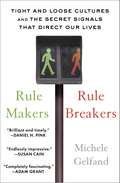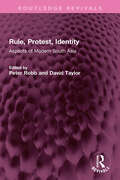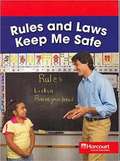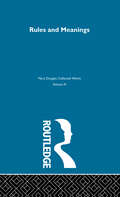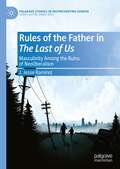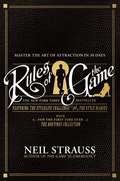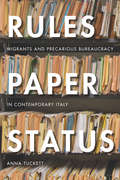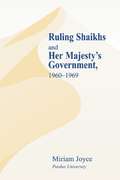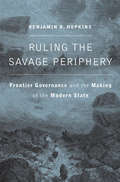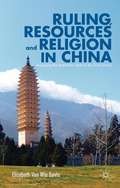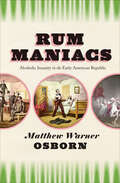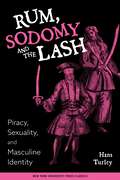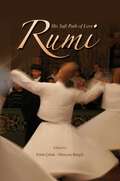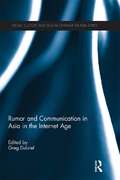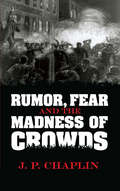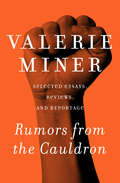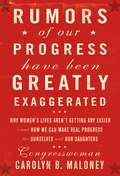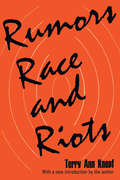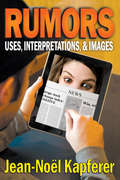- Table View
- List View
Rule By Incarnation: Tibetan Buddhism And Its Role In Society And State
by Franz MichaelThe 1959 Chinese military takeover of Tibet brought an end to a unique way of life in which Buddhism provided legitimacy to political and social authority in Tibet and served as value system, cultural bond, philosophy of life, and framework for a complex political and social order. The religious-political system of Tibet now exists only in the memories of those who experienced it. This book documents the human heritage and cultural traditions of Tibet's singular society as they developed and existed during a period of several hundred years. Using Max Weber's framework of the interrelationship between religious ideologies and the emergence of social, economic, and political systems, Franz Michael and his colleagues analyze the concepts that are central to Tibetan Buddhism and apply them to the Tibetan people, their social and political order, and their way of life. Much of the study is based on interviews with Tibetans in exile-from incarnations and highly placed ecclesiastical and secular government leaders to farmers, herdsmen, and housewives. The result is important not only as the record of a culture, but also as it is related by the authors to the broader issue of the modernization of non-Western traditional societies.
Rule Makers, Rule Breakers: How Tight and Loose Cultures Wire Our World
by Michele GelfandA celebrated social psychologist offers a radical new perspective on cultural differences that reveals why some countries, cultures, and individuals take rules more seriously and how following the rules influences the way we think and act.In Rule Makers, Rule Breakers, Michele Gelfand, &“an engaging writer with intellectual range&” (The New York Times Book Review), takes us on an epic journey through human cultures, offering a startling new view of the world and ourselves. With a mix of brilliantly conceived studies and surprising on-the-ground discoveries, she shows that much of the diversity in the way we think and act derives from a key difference—how tightly or loosely we adhere to social norms. Just as DNA affects everything from eye color to height, our tight-loose social coding influences much of what we do. Why are clocks in Germany so accurate while those in Brazil are frequently wrong? Why do New Zealand&’s women have the highest number of sexual partners? Why are red and blue states really so divided? Why was the Daimler-Chrysler merger ill-fated from the start? Why is the driver of a Jaguar more likely to run a red light than the driver of a plumber&’s van? Why does one spouse prize running a tight ship while the other refuses to sweat the small stuff? In search of a common answer, Gelfand spent two decades conducting research in more than fifty countries. Across all age groups, family variations, social classes, businesses, states, and nationalities, she has identified a primal pattern that can trigger cooperation or conflict. Her fascinating conclusion: behavior is highly influenced by the perception of threat. &“A useful and engaging take on human behavior&” (Kirkus Reviews) with an approach that is consistently riveting, Rule Makers, Ruler Breakers thrusts many of the puzzling attitudes and actions we observe into sudden and surprising clarity.
Rule, Protest, Identity: Aspects of Modern South Asia (Routledge Revivals)
by David Taylor Peter RobbFirst published in 1978, Rural, Protest, Identity consists of eleven essays on modern South Asia. Its concern is with the diversity of the region, to suggest how its study may be enriched by the juxtaposition of various disciplines, and in particular through the examination of familiar subjects from less familiar points of view. Four papers deal with the ruling of modern India. One examines the relationship between the British government and an Indian state, one the legal implications of the emergency under Mrs. Gandhi, and two the role of civil servants in the formation of Indian government policy. Four more papers deal with aspects of protest movements: one with British Ceylon, one with a follower of Gandhi, and two with Gandhi himself. Three final papers treat questions of identity from literary or linguistic standpoints. Two discuss ideas or stereotypes as expressed in famous books, and the third considers a linguistic movement in Pakistan. This book will be of interest to student of South Asian studies, history, economics, literature and political science.
Rules and Laws Keep Me Safe: Below-level Reader (Harcourt School Publishers Social Studies)
by Harcourt School PublishersRules and Laws Keep Me Safe by Harcourt School Publishers Social Studies
Rules and Meanings
by Mary DouglasFirst published in 1973, Rules and Meanings is an anthology of works that form part of Mary Douglas' struggle to devise an anthropological modernism conducive to her opposition to reputedly modernizing trends in contemporary society. The collection contains works by Wittgenstein, Schutz, Husserl, Hertz and other continentals. The underlying themes of the anthology are the construction of meaning, the force of hidden background assumptions, tacit conventions and the power of spatial organization to reinforce words. The work serves to complement the philosophers' work on everyday language with the anthropologists' theory of everyday knowledge.
Rules of the Father in The Last of Us: Masculinity Among the Ruins of Neoliberalism (Palgrave Studies in (Re)Presenting Gender)
by J. Jesse RamirezWidely regarded by critics and fans as one of the best games ever produced for the Sony Playstation, The Last of Us is remarkable for offering players a narratively rich experience within the parameters of cultural and gaming genres that often prioritize frenetic violence by straight white male heroes. The Last of Us is also a milestone among mainstream, big-budget (AAA) games because its development team self-consciously intervened in videogames’ historical exclusion of women and girls by creating complex and agentive female characters. The game’s co-protagonist, Ellie, is a teenage girl who is revealed to be queer in The Last of Us: Left Behind (DLC, 2014) and The Last of Us II (2020). Yet The Last of Us also centers Joel, Ellie’s fatherly protector.How is patriarchy, the rule of the father, encoded in rule-based systems like videogames? How does patriarchal rule become an algorithmic rule and vice-versa? These questions are at the heart of this book, the first comprehensive scholarly analysis of the zombie apocalypse/ action-adventure/ third-person shooter videogame The Last of Us (2013). On the one hand, the book is a close, extended study of The Last of Us and its themes, genres, procedures, and gameplay. On the other hand, the book is a post-GamerGate reflection on the political and ethical possibilities of progressive play in algorithmic mass culture, of which videogames are now the dominant form.
Rules of the Game
by Neil StraussIf you want to play the Game, you've got to know the Rules. In his international bestseller The Game, Neil Strauss delved into the secret world of pick-up artists-men who have created a science out of the art of seduction. Not only did he reveal the techniques that they had developed, but he became a master of The Game, and the world's No. 1 PUA, as Style. Now, in this bestselling companion, Strauss reduces three books of life-changing knowledge into a single-volume set. The first book, The Stylelife Challenge, breaks down the knowledge he learned and techniques he invented into simple step-by-step instructions that anyone can follow to meet and land the women of their dreams. In the second book, Strauss takes readers into the dark side of The Game. The Style Diaries offers a series of tales of seduction and sexual (mis)adventure. From accidentally getting married during a drunken night in Reykjavik, to luring a famous musician's granddaughter into a threesome; to the stress and frustration of the torturous and highly unorthodox "30 Day Sex Experiment," The Style Diaries takes you further into the seduction underworld than ever before. Finally, in the all-new, updated third volume, Strauss collects the greatest, most powerful, field-tested, word-for-word routines. You don't need money, looks, or fame to succeed with women. All you need is an understanding of how attraction works-and this thirty-day workout program for your social skills, which has already guided countless men from frustration to fulfillment.
Rules of the Road: The Automobile and the Transformation of American Criminal Justice
by Spencer HeadworthA thorough and engaging look at an unexpected driver of changes in the American criminal justice system Driving is an unavoidable part of life in the United States. Even those who don't drive much likely know someone who does. More than just a simple method of getting from point A to point B, however, driving has been a significant influence on the United States' culture, economy, politics – and its criminal justice system. Rules of the Road tracks the history of the car alongside the history of crime and criminal justice in the United States, demonstrating how the quick and numerous developments in criminal law corresponded to the steadily rising prominence, and now established supremacy, of the automobile. Spencer Headworth brings together research from sociology, psychology, criminology, political science, legal studies, and histories of technology and law in illustrating legal responses to changing technological and social circumstances. Rules of the Road opens by exploring the early 20th-century beginnings of the relationship between criminal law and automobility, before moving to the direct impact of the automobile on prosecutorial and criminal justice practices in the latter half of the 20th century. Finally, Headworth looks to recent debates and issues in modern-day criminal justice to consider what this might presage for the future. Using a seemingly mundane aspect of daily life as its investigative lens, this creative, imaginative, and thoroughly researched book provides a fresh perspective on the transformations of the U.S. criminal justice system.
Rules, Exceptions, and Social Order
by Robert B. EdgertonThis title is part of UC Press's Voices Revived program, which commemorates University of California Press’s mission to seek out and cultivate the brightest minds and give them voice, reach, and impact. Drawing on a backlist dating to 1893, Voices Revived makes high-quality, peer-reviewed scholarship accessible once again using print-on-demand technology. This title was originally published in 1985.
Rules, Paper, Status: Migrants and Precarious Bureaucracy in Contemporary Italy
by Anna TuckettWhether motivated by humanitarianism or concern over "porous" borders, dominant commentary on migration in Europe has consistently focused on clandestine border crossings. Much less, however, is known about the everyday workings of immigration law inside borders. Drawing on in-depth ethnographic fieldwork in Italy, one of Europe's biggest receiving countries, Rules, Paper, Status moves away from polarized depictions to reveal how migration processes actually play out on the ground. Anna Tuckett highlights the complex processes of inclusion and exclusion produced through encounters with immigration law. The statuses of "legal" or "illegal," which media and political accounts use as synonyms for "good" and "bad," "worthy" and "unworthy," are not created by practices of border-crossing, but rather through legal and bureaucratic processes within borders devised by governing states. Taking migrants' interactions with immigration regimes as its starting point, this book sheds light on the productive nature of legal and bureaucratic encounters and the unintended consequences they produce. Rules, Paper, Status argues that successfully navigating Italian immigration bureaucracy, which is situated in an immigration regime that is both exclusionary and flexible, requires and induces culturally specific modes of behavior. Exclusionary laws, however, can transform this social and cultural learning into the very thing that endangers migrants' right to live in the country.
Ruling Shaikhs and Her Majesty's Government, 1960-1969: 1960-1969
by Miriam JoyceThis volume discusses the evolution of the British-protected Gulf states during the 1960s and explains how these small Shaikhdoms moved towards independence. Based on extensive research using British documents from the Public Records Office and selected American documents from the National Archives, this book investigates the relationship between British officials and Arab Gulf Shaikhs. At the beginning of what was to be their final years as guardians of the Gulf, British officials pressed for political progress, co-operation among the Shaikhdoms and improvements in education and health care. At the same time, Foreign Office officials continued to safeguard specific British economic interests and the political interests of the Western Alliance.
Ruling by Schooling Quebec
by Bruce CurtisRuling by Schooling Quebec provides a rich and detailed account of colonial politics from 1760 to 1841 by following repeated attempts to school the people. This first book since the 1950s to investigate an unusually complex period in Quebec's educational history extends the sophisticated method used in author Bruce Curtis's double-award-winning Politics of Population.Drawing on a mass of archival material, the study shows that although attempts to govern Quebec by educating its population consumed huge amounts of public money, they had little impact on rural ignorance: while near-universal literacy reigned in New England by the 1820s, at best one in three French-speaking peasant men in Quebec could sign his name in the insurrectionary decade of the 1830s. Curtis documents educational conditions on the ground, but also shows how imperial attempts to govern a tumultuous colony propelled the early development of Canadian social science. He provides a revisionist account of the pioneering investigations of Lord Gosford and Lord Durham.
Ruling the Savage Periphery: Frontier Governance and the Making of the Modern State
by Benjamin D. HopkinsA provocative case that “failed states” along the periphery of today’s international system are the intended result of nineteenth-century colonial design. From the Afghan frontier with British India to the pampas of Argentina to the deserts of Arizona, nineteenth-century empires drew borders with an eye toward placing indigenous people just on the edge of the interior. They were too nomadic and communal to incorporate in the state, yet their labor was too valuable to displace entirely. Benjamin Hopkins argues that empires sought to keep the “savage” just close enough to take advantage of, with lasting ramifications for the global nation-state order. Hopkins theorizes and explores frontier governmentality, a distinctive kind of administrative rule that spread from empire to empire. Colonial powers did not just create ad hoc methods or alight independently on similar techniques of domination: they learned from each other. Although the indigenous peoples inhabiting newly conquered and demarcated spaces were subjugated in a variety of ways, Ruling the Savage Periphery isolates continuities across regimes and locates the patterns of transmission that made frontier governmentality a world-spanning phenomenon. Today, the supposedly failed states along the margins of the international system—states riven by terrorism and violence—are not dysfunctional anomalies. Rather, they work as imperial statecraft intended, harboring the outsiders whom stable states simultaneously encapsulate and exploit. “Civilization” continues to deny responsibility for border dwellers while keeping them close enough to work, buy goods across state lines, and justify national-security agendas. The present global order is thus the tragic legacy of a colonial design, sustaining frontier governmentality and its objectives for a new age.
Ruling, Resources and Religion in China
by Elizabeth Van Wie DavisChina is growing in importance to the economies and governments of the world, and it has been run by men with very different ideas. How China copes with the pressures for good governance with the Asian economic model, treats its ethnic minorities under scrutiny, and gathers resources to fuel its dynamic economy, impacts us all.
Rum Maniacs: Alcoholic Insanity in the Early American Republic
by Matthew Warner Osborn"This important study explores the medicalization of alcohol abuse in the 19th century US&” and its influence on American literature and popular culture (Choice). In Rum Maniacs, Matthew Warner Osborn examines the rise of pathological drinking as a subject of medical interest, social controversy, and lurid fascination in 19th century America. At the heart of that story is the disease that afflicted Edgar Allen Poe: delirium tremens. Poe&’s alcohol addiction was so severe that it gave him hallucinations, such as his vivid recollection of standing in a prison cell, fearing for his life, as he watched men mutilate his mother&’s body—an event that never happened. First described in 1813, delirium tremens and its characteristic hallucinations inspired sweeping changes in how the medical profession saw and treated the problems of alcohol abuse. Based on new theories of pathological anatomy, human physiology, and mental illness, the new diagnosis established the popular belief that habitual drinking could become a psychological and physiological disease. By midcentury, delirium tremens had inspired a wide range of popular theater, poetry, fiction, and illustration. This romantic fascination endured into the twentieth century, most notably in the classic Disney cartoon Dumbo, in which a pink pachyderm marching band haunts a drunken young elephant. Rum Maniacs reveals just how delirium tremens shaped the modern experience of alcohol addiction as a psychic struggle with inner demons.
Rum Punch and Revolution: Taverngoing and Public Life in Eighteenth-century Philadelphia
by Peter Thompson'Twas Honest old Noah first planted the Vine, And mended his morals by drinking its Wine. --from a drinking song by Benjamin Franklin. There were, Peter Thompson notes, some one hundred and fifty synonyms for inebriation in common use in colonial Philadelphia and, on the eve of the Revolution, just as many licensed drinking establishments. Clearly, eighteenth-century Philadelphians were drawn to the tavern. In addition to the obvious lure of the liquor, taverns offered overnight accommodations, meals, and stabling for visitors. They also served as places to gossip, gamble, find work, make trades, and gather news. In Rum Punch and Revolution, Thompson shows how the public houses provided a setting in which Philadelphians from all walks of life revealed their characters and ideas as nowhere else. He takes the reader into the cramped confines of the colonial bar room, describing the friendships, misunderstandings and conflicts which were generated among the city's drinkers and investigates the profitability of running a tavern in a city which, until independence, set maximum prices on the cost of drinks and services in its public houses. Taverngoing, Thompson writes, fostered a sense of citizenship that influenced political debate in colonial Philadelphia and became an issue in the city's revolution. Opinionated and profoundly undeferential, taverngoers did more than drink; they forced their political leaders to consider whether and how public opinion could be represented in the counsels of a newly independent nation.
Rum, Sodomy, and the Lash: Piracy, Sexuality, and Masculine Identity
by Hans TurleyAn examination into the homoerotic and other transgressive aspects of the pirate's worldDespite, or perhaps because of, our lack of actual knowledge about pirates, an immense architecture of cultural mythology has arisen around them. Three hundred years of novels, plays, painting, and movies have etched into the popular imagination contradictory images of the pirate as both arch-criminal and anti-hero par excellence. How did the pirate-a real threat to mercantilism and trade in early-modern Britain-become the hypermasculine anti-hero familiar to us through a variety of pop culture outlets? How did the pirate's world, marked as it was by sexual and economic transgression, come to capture our collective imagination? In Rum, Sodomy, and the Lash, Hans Turley delves deep into the archives to examine the homoerotic and other culturally transgressive aspects of the pirate's world and our prurient fascination with it. Turley fastens his eye on historical documents, trial records, and the confessions of pirates, as well as literary works such as Robinson Crusoe, to track the birth and development of the pirate image and to show its implications for changing notions of self, masculinity, and sexuality in the modern era. Turley's wide-ranging analysis provides a new kind of history of both piracy and desire, articulating the meaning of the pirate's contradictory image to literary, cultural, and historical studies.
Rumi And His Sufi Path Of Love
by Faith CitlakThis collection of articles by artists, philosophers, psychologists, and social scientists explores the Sufi tradition and its best-known teacher, Rumi, a 13th-century poet, jurist, and philosopher. Setting aside the standard account of Rumi as a poet of mystic love, these contributors view his writings in a historical context, investigating Sufism''s ties to Islam and the teachings of the Prophet Mohammad and tracing Rumi''s influence on Persian and Turkish literature. The reasons why Sufism has transcended national boundaries and sectarian strife so successfully are also debated, and several contributors recommend the Sufi message of faith, love, and tolerance as a useful common ground for dialogue between religious groups.
Rumination-Focused Cognitive-Behavioral Therapy for Depression
by Edward R. WatkinsFrom a leading clinician-researcher, this book presents an empirically tested approach for helping clients with severe and chronic depression by directly tackling negative rumination. Rumination-focused cognitive-behavioral therapy (RFCBT) combines carefully adapted elements of CBT with imagery, visualization, and compassion-based techniques. The book provides everything needed to implement this 12-session approach, including numerous sample dialogues, a chapter-length case example, reflections and learning exercises for therapists, and 10 reproducible client handouts. Purchasers get access to a Web page where they can download and print the reproducible materials in a convenient 8 1/2" x 11" size.
Rumor and Communication in Asia in the Internet Age (Media, Culture and Social Change in Asia)
by Greg DalzielNew communication technology has transformed the way in which news about key events is communicated. For example, in the immediate aftermath of catastrophic events such as the Mumbai attacks or the Japanese tsunami, partial accounts, accurate and inaccurate facts, rumour and speculation are now very rapidly disseminated across the globe, often ahead of official announcements and formal news reporting. Often in such situations rumours take hold, and continue to characterise events even after a more complete, more accurate picture eventually emerges. This book explores how such rumours are created, disseminated and absorbed in the age of the internet and mobile communications. It includes a wide range of examples and, besides considering the overall processes involved, engages with scholarly debates in the field of media and communication studies.
Rumor, Fear and the Madness of Crowds
by J. P. ChaplinMartians, a reincarnated Irish woman, a dead movie star, an insane anesthetist, and an obsessed U.S. Attorney General - these disparate characters have something in common. Each was at the center of an incident of mass hysteria, in which frightened, grieving, and otherwise disturbed people abandoned their common sense. This fascinating book by a prominent psychologist explores several intriguing case histories of mass hysteria, from "The Great Disappointment" of 1926, in which thousands of believers dressed in white to await Jesus' return, to UFO sightings and other extraordinary phenomena.Author J. P. Chaplin examines historical incidents of mob mentality, including "The Last Days of Rudolph Valentino," which culminated in a New York City riot of 80,000 mourning fans; "The Secrets of the Nunnery," involving the sack of a Boston convent by an angry crowd in search of children's skulls; "The Martians Invade New Jersey," in which a radio drama was mistaken for a news broadcast; and other remarkable instances of mass delusion.
Rumors from the Cauldron: Selected Essays, Reviews, and Reportage
by Valerie MinerAn indispensable collection of essays reflecting on the historical and cultural relevance of feminist movements across the globe In these remarkably far-reaching writings, author and journalist Valerie Miner delivers a complex and engaging volume of essential reading. This book touches on topics ranging from suburban housewives to lesbian identity to feminist thought. Miner provides an important perspective on the interrelated concepts of authorship, gender identity, and social criticism. Included are examinations of the works of Grace Paley, Margaret Atwood, and May Sarton, meditations on writing, and reflections on the cultural legacy of feminism.Miner&’s insights are both perspicacious and thought provoking. Written with profound passion and knowledge, these tracts are of tremendous value to all readers engaged with the politics of equality.
Rumors of Our Progress Have Been Greatly Exaggerated: Why Women's Lives Aren't Getting Any Easier--And How We Can Make Real Progress F or Ourselves and Our Daughters
by Carolyn MaloneyAs a young woman, Democratic Congresswoman Carolyn Maloney asked her grandmother for career advice. She was shocked by the reply: "Get married." Though much has changed for women since then, more has remained the same. On a January night in 2008, Maloney and her daughter attended a Hillary Clinton rally in New Hampshire. Some men in the audience held "Iron My Shirt" posters aloft. This small incident provoked outrage, but it provided an important peephole onto larger problems that women face today. In her groundbreaking book, Rumors of Our Progress Have Been Greatly Exaggerated, Congresswoman Maloney shatters the myths about how far we've come, highlighting how women's issues permeate every realm of society, and how political change has provided only a fraction of a solution. The former cochair of the Women's Caucus, Maloney has access to a wealth of cutting-edge research that helps her illuminate how far behind we still fall on gender equality in issues from health care to educational opportunities, from poverty to reproductive freedom. It's a fact that women are working harder than ever, but they're still only paid three-quarters the salary of their male counterparts. She weaves this vital information with gripping stories of real women, making clear that she's not taking some abstract political position. She's talking about real people, real lives. Maloney also points the way forward, sharing inspiring tales of female activists who have managed to make a difference and presenting readers with "take action" guides that show all women practical ways they can help bring about change in their lives and the lives of others.
Rumors, Race and Riots (Rumours, Race And Riots Ser.)
by Terry Ann KnopfAre race-related rumors rooted in the personality traits of the individual? Are they a kind of "improvised news" for a community? Do they come and go at random or form definite, recognizable patterns? What role do the news media play in spreading rumors? These and other questions are treated in this classic study, now available in paperback with a new introduction by the author, of how and why rumors emerge in connection with racial disorders.Included is an examination and critique of the three major models of rumor formation: the psychological approach, emphasizing the emotional needs and drives of the individual; the functional approach, which views rumors as a form of "improvised news"; and the conspiratorial approach, which sees rumors as deliberately planted and not spontaneous.The author's "process model" of rumor formation is based on the premise that rumors cannot "cause" violence and that violence cannot "cause" rumors. Both are viewed as parts of the same process. Rumors are seen as just one of a series of determinants, each of which increases the likelihood of a collective outburst. Among the determinants examined are: conditions of stress; a rigid social structure supported by a racist ideology; and a hostile belief system (or negative set of generalized perceptions) held separately by different groups. Race-related rumors are functionally tied to the latter point and crystallize, confirm, and intensify these beliefs by linking them to actual events.Hundreds of pertinent rumors are documented from local newspapers and investigative accounts. An exhaustive, systematic inquiry is made into the series of disorders that occurred between 1967 and 1970. The role played by rumors during these disturbing times is examined and compared to earlier periods of unrest. Implications for public policy are explored along with a hard look at rumor-control centers. The influence of the police and other public officials as well as the news media are
Rumors: Uses, Interpretation and Necessity
by Jean-Noel KapfererRumors may be the oldest medium of mass communication of information or ideas. Even before there were newspapers, radio, or television, rumors communicated by word-of-mouth made and shattered reputations, and set off riots and wars. Yet contrary to predictions, rumors continue to thrive, in spite of and parallel to mass media.What accounts for the puzzling persistence and continuing significance of this little-studied social phenomenon? Jean-No;el Kapferer examines the theory and practice of rumors, focusing on specific areas such as entertainment, criminal behavior, business and finance, and politics. He describes the kinds of conditions that give birth to rumors, why we believe them, and the hidden messages they convey. Kapferer points out that rumors frequently serve useful social purposes and present rich examples. He speculates about how rumors can be controlled, changed, and prevented.Drawing upon contributions of disciplines ranging from psychology to history, and integrating the insights of Europeans with the latest work of American researchers, this is the most comprehensive examination of rumors, gossip, and urban legends yet published. Translated into nine languages, this edition was updated with advances in theory and research since the book's original French publication in 1987. Its brisk, accessible style makes the book of interest to psychologists, economists, political scientists, sociologists, and folklore analysts, as well as the general reader who is curious about the origins of this fascinating social phenomenon.

